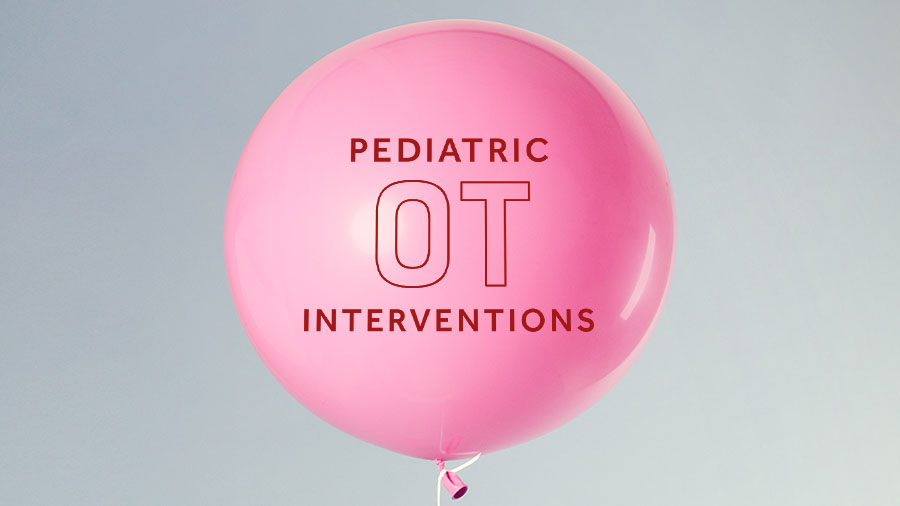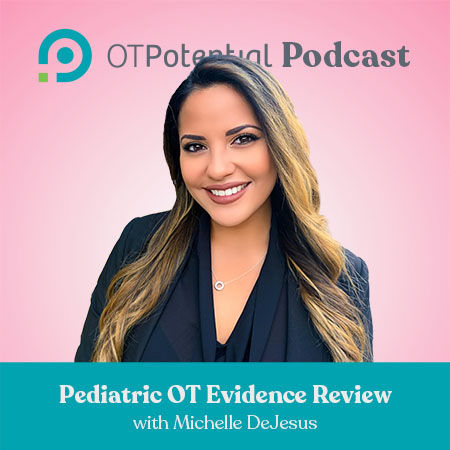
Occupational therapists take a holistic approach to health and thus utilize a wide variety of treatment options.
In this post, we wanted to help you see the level of evidence behind some of the most common interventions utilized by pediatric occupational therapists.
The information for this post is derived from the incredible article Effectiveness of paediatric occupational therapy for children with disabilities: A systematic review (2019) which is available for you to read for free in its entirety.
You’ll see below the treatment options are organized by the outcomes they are targeting. And, the authors assigned them a “green,” “yellow,” or “red” light to indicate whether you should move forward with the option, based on the available evidence.
Overall trends in effective pediatric OT interventions
Before we look at the full list, I wanted to highlight two overarching trends in effective OT interventions that were highlighted by the authors:
1. Parent partnership is effective and worthwhile.
For the diagnoses studied, it was very clear that parents respond well to education and training. Therefore, home programs and self-management training are effective ways to increase the intensity of treatment.
2. Activity-based (a.k.a. top-down) interventions lead to better gains.
The authors shared that interventions that involve actually practicing activities have the highest percentage of “green-light” evidence. (In OT, we call this a top-down approach, instead of bottom-up which is focused on the body level.)
When it comes to the interventions with the strongest evidence, the authors identified four key ingredients they have in common:
- They begin with the child’s goal.
- They involve practicing real-life activities in natural environments.
- They use intense repetitions to activate plasticity.
- They use scaffolding to find the “just right challenge.”
Pediatric diagnoses explored
In their review of literature, 22 diagnoses were included in the research..
- Arthrogryposis
- Attention deficit hyperactivity disorder (ADHD)
- Autism spectrum disorder (ASD)
- Behavior disorders
- Brachial plexus injury
- Brain injury (BI)
- Burns
- Cerebral palsy (CP)
- Cancer
- Chronic pain
- Developmental coordination disorder (DCD)
- Developmental disability (DD)
- Down syndrome
- Fetal alcohol spectrum disorder
- Learning disability (LD)
- Mental health
- Intellectual disability (ID)
- Obesity
- Preterm infants
- Physical disability
- Rheumatoid arthritis
- Spina bifida
52 Pediatric Interventions Grouped by Outcomes, Evidence Level, and Diagnosis
When the treatment approach has a dedicated website, we did our best to link to it! Below! You’ll see the outcomes explored are:
To see the research behind each intervention, and to learn more about the specific way the intervention was implemented, please refer back to the original journal article.
You can also reference the original bubble chart to see the interventions mapped out with even more detail.
Motor Outcomes Interventions
Do It:
🟢 CIMT – Cerebral Palsy (CP)
🟢 Handwriting Task Practice – DCD
🟢 EI Developmental Approach – Preterm infants
🟢 Bimanual – CP
🟢 OT+BoNTA – CP
🟢 Goal-directed Training – CP
🟢 Home Program – CP
🟢 The CO-OP Approach – DCD
🟢 Treadmill – Down Syndrome
Probably Do It:
🟠 Positioning – CP
🟠 Orthotics – Brachial Plexus, CP, Hypermobility
🟠 Visual Motor – DD
🟠 Casting – CP
🟠 EI GAME – CP
🟠 The CO-OP Approach – ASD, CP
🟠 Assistive Tech VR – CP, DCD
🟠 Hippotherapy – ASD, CP
🟠 Skills Training Mental Rehearsal – DCD
🟠 Treadmill – CP, Mixed
🟠 Yoga – ASD
🟠 Bio-feedback – CP
🟠 Body Vibration – CP, Mixed
🟠 School Therapy – DD
Probably Don’t Do It:
🟠 Conductive Education – CP
🟠 Orthotics – JRA
🟠 Stretch – CP, Mixed
🟠 Sensory Approach – CP, DCD, Mixed
🟠 Sensory Integration – CP, DCD
Don’t Do It:
🔴 NDT – CP
🔴 Handwriting Sensory Approach – DCD
Behavioral Outcomes
Do It:
🟢 Triple P – Behav Dis
🟢 Pain Management – Mixed (Pain)
🟢 Ditto™ – Burns (Pain)
Probably Do It:
🟠 Assistive Tech Smart Phones – Behav Dis
🟠 Meditation – ADHD, ASD
🟠 Triple P – ADHD
🟠 Massage – CP (Pain)
Probably Don’t Do It:
🟠 Sensory Approach – ADHD, ASD
Don’t Do It:
🔴 Sensory Integration – ASD
Function
Do It:
🟢 Family Centered Care – Bi, CP
🟢 Goal-Directed Care – CP
🟢 Home Program – CP, ID
🟢 Context Focused – CP
🟢 Parent Education – Mixed (Feeding)
🟢 Physiological – Mixed (Feeding)
Probably Do It:
🟠 Assistive Devices – CP, Mixed
🟠 Task Training Mental Imagery – ASD
🟠 Ball Skills – DCD
🟠 Sensory Approach – ASD
🟠 Self Management – Spina Bifida, Mixed (Self Management)
🟠 SI – ASD (Feeding)
Probably Don’t Do It:
🟠 Therasuits – ASD
Don’t Do It:
🔴 Sensory Integration – ASD
Cognitive Outcomes
Do It:
🟢 EI Developmental Approach – Preterm
🟢 Cog-Fun – ADHD
🟢 ALERT Program – FASD
🟢 CAPS – BI
Probably Do It:
🟠 TEACCH – ASD, Mixed
🟠 Play Therapy AdPT – ASD
🟠 DIR Floortime – ASD
🟠 Assistive Tech VR – BI, Phys Dis
🟠 Time Aides – ADHD
🟠 Home Program – ASD
🟠 Play Therapy – CP
🟠 Proprioceptive – Hypermob (Sense)
🟠 Sensation Training – CP (Sense)
🟠 Sleep Hygiene – ASD (Sleep)
Probably Don’t Do It:
🟠 CogMed – ADHD
Don’t Do It:
🔴 Sensory Integration – ASD
🔴 Weighted Blankets – ASD (Sleep)
Parent Outcomes
Do It:
🟢 Coaching – ASD, At Risk
🟢 Problem Solving – ASD
🟢 Parent Education – Mixed
🟢 Mindfulness – ASD
🟢 Joint Attention – ASD (Social)
🟢 PECS – ASD (Social)
🟢 Peer Mediated – ASD (Social)
🟢 Health Promotion – Mental Health (Mental Health)
🟢 Life Skills Training – DD (Mental Health)
Probably Do It:
🟠 Parent Education – ADHD, ASD, BI, CP
🟠 Counseling – CP
🟠 Coaching – Behav Dis, BI, CP, DD, LD
🟠 Attachment Training – ASD
🟠 Play Therapy – CP
🟠 DIR Floortime – ASD (Social)
🟠 Sleep Hygiene – ASD (Mental Health)
Probably Don’t Do It:
🟠 None
Don’t Do It:
🔴 None
A few caveats
The evidence base behind OT is always evolving, and this particular grouping of interventions represents a snapshot in time (from 2019) and was compiled by two authors—so there is the possibility of bias.
But, even though the list may not be perfect, we do believe this gives you a great starting point for understanding the treatment options available.
Omitted OT interventions
There are a couple interventions that were green-lit on the original review that we, at OT Potential, consider to be controversial, as they have the potential for long-term harm and are not autistic-affirming, as designated by the autistic community.
So, we decided NOT to include them in our list below, even though they were included in the original article. These interventions include: ABA, token economies, social skills training, and behavioral interventions.
For more information on this, check out the Autistic Self Advocacy Network website, and for a deep dive read their article on the ethics of autism interventions.
Conclusion
We hope this article has helped to give you a glimpse of the types of interventions pediatric occupational therapists utilize and how we weigh the evidence behind them! If you would like to hear a discussion of the trends behind the green-lit pediatric interventions, check out my podcast episode with Michelle DeJesus “Pediatric OT Evidence Review.”
Finally, as we mentioned in the beginning, OT research is always evolving and we look forward to updating this post again in the future!

